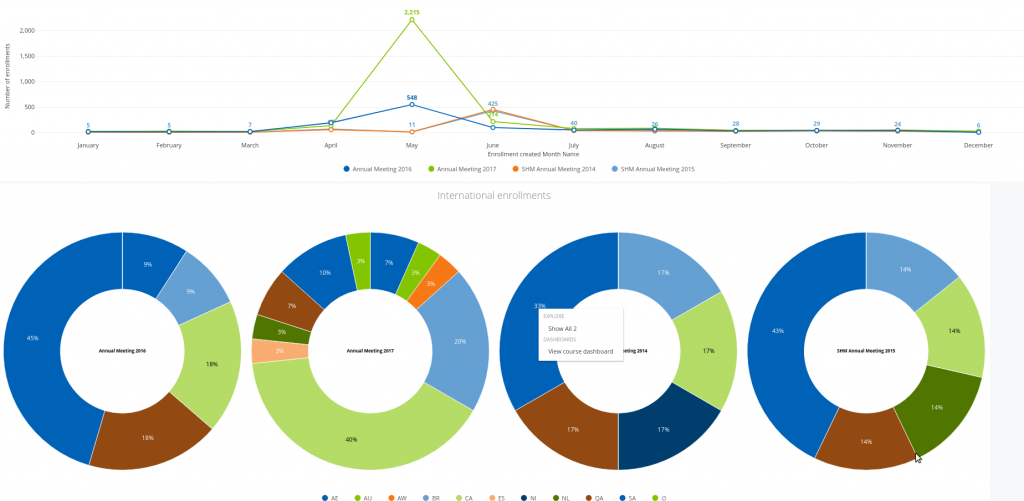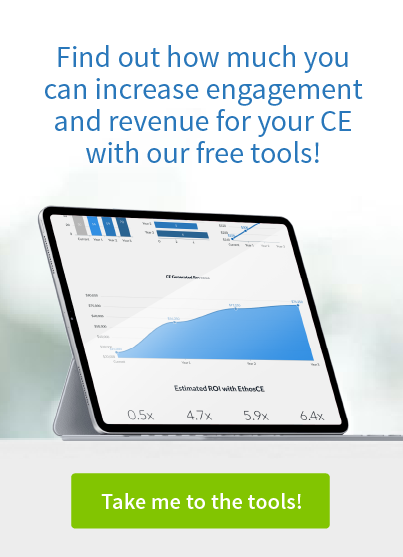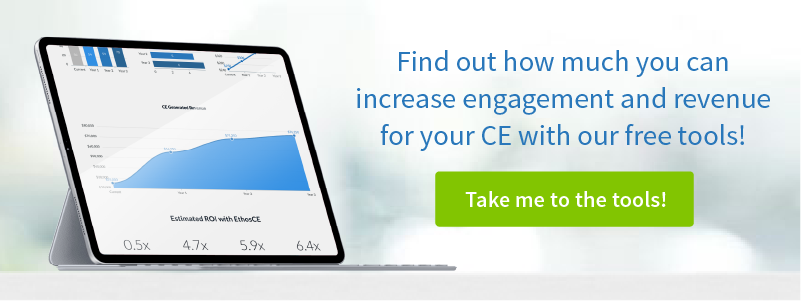Introducing EthosCE Analytics: Business Intelligence for Medical Associations and Universities
As you may know, EthosCE is the premier and enterprise-grade LMS designed entirely around CE for the medical profession. We are proud to announce a suite of powerful business intelligence features called EthosCE Analytics. This new part of our platform offers medical education providers unparalleled data management, analytics, and data-driven forecasting features in a single dashboard.
An End to Spreadsheets: Single-Click Self-Service Reporting
One of EthosCE’s most exciting learner intelligence features is self-service reporting and data exploration. With a few clicks, CME Coordinators, Directors, or Executives can generate individual reports that cover the entire timeline of learners’ activities engagement, course completion rates, and LMS browsing history, eliminating the need for manual data handling. Segmented data can also be displayed and shared through embeddable dashboards, allowing CME administrators to have critical data at their fingertips whenever they need it.
Reports are anything but canned. Data visualizations can be tailored to setting and end-user, and are:
- Web-native, cross-browser and cross-device
- Interactive
- Drag and drop for painless editing
Reports use elegant, high-impact data visualizations from an expansive template library to make insights simple to grasp and a pleasure to view.

Here are just a few examples:
Reports may be downloaded, emailed or printed.
Sharing and managing reports are just as easy as creating them. Users can:
- Use an URL with role-based viewing permissions to share across the organization
- Reports can be scheduled for delivery through email, webhooks, chat, S3 or FTP
- Export, download locally, upload, then import
- Export data to Google Drive, Dropbox, and S3
Not only can these comprehensive reports serve as an evidence-based foundation for the ACCME Self Study, they can also provide a basis for day-to-day resource allocation decisions and user outreach initiatives.
No More Data Silos: Rich, Shareable, Data Insights for All
Here are just a few of the data points that CME professionals can access:
- Learner engagement levels, filtered by course, topic, and/or demographic
- At-risk and high achieving learner assessment data
- Site usage and engagement rates comparisons to similar organizations
- Learner outcomes patterns for courses
Data pulls can also be developed ala carte and included in reports using custom fields.

When it comes to data management, new EthosCE Analytics features offer CME Coordinators, Directors, and Executives exceptional transparency in a highly secure environment.
From Insights to Improved Learner Outcomes: Frictionless Curriculum Updates
In addition, EthosCE’s learner-centric instructional design tools allow course administrators to instantly address users’ educational needs by fine-tuning activities formats at every level with a few clicks. From the introduction of new quizzes and multimedia components to enhance knowledge retention to the removal of individual questions assessments that are problematic for certain learners— instructional designers have complete control over their students’ learning experience.
The Importance of Data Accuracy in ACCME Compliance
For CME professionals, one of the most time-consuming tasks in maintaining compliance is data management. For example, to close an activity in PARS, a report must include the following, among other data:
The following fields are required to complete, or “close,” an activity in PARS.
- Providership (Direct or Joint)
- Hours of Instruction
- Designed to change (Competence, Performance or Patient Outcomes)?
- Changes in (Competence, Performance or Patient Outcomes) evaluated?
- Number of physicians (including residents) who participated in the activity
- Number of other learners who participated in the activity
- Commercial Support Received? (Y/N)
Outdated or inaccurate data can corrupt the PARS report, underrepresenting your achievements, or presenting a portrait of learner outcome history that will not stand up under scrutiny.
Effective data collection and the analysis of improvement in the performance of learners are key compliance criteria:
The provider analyzes changes in learners (competence, performance, or patient outcomes) achieved as a result of the overall program’s activities/educational interventions.
The provider gathers data or information and conducts a program-based analysis on the degree to which the CME mission of the provider has been met through the conduct of CME activities/educational interventions.
For many CME professionals, one of the most difficult challenges in staying compliant is developing a process of evaluation for changes in levels of competence, especially as this information is required for each CME activity.
EthosCE removes the guesswork from outcomes evaluation, making changes in levels of competence over time via assessment data and learner feedback through the LMS effortless.
While EthosCE has always provided customers with enterprise-grade data management, CME professionals can now develop highly accurate reports on learner outcomes with a few clicks, using the granular insights that can only come from rich data.
For more than a decade, EthosCE has worked with medical associations to build CME programs which have helped more than 500 thousand health professionals earn more than 6 million continuing education (CE) credits.
CME providers using the all-in-one, user-friendly SaaS will have a complete CME management and LMS solution that brings critical data and curriculum development tasks to a single dashboard.
To learn more about EthosCE’s latest analytics and reporting features, click here to request a tour here or schedule a 1-on1 demonstration here!
 We're now part of the Cadmium product suite! Learn more
We're now part of the Cadmium product suite! Learn more 



[…] “Dirty” data is inaccurate or incomplete. Often it is the fault of an entry error into a spreadsheet or a change in status that was not updated. Regardless of the reason, missing data can lead to a non-compliance finding. If your data management practices can’t pass our checkup, then it is likely a document tracking or storage issue that can be easily fixed by switching to a system that allows you to manage your data from a single dashboard. […]
Comments are closed.